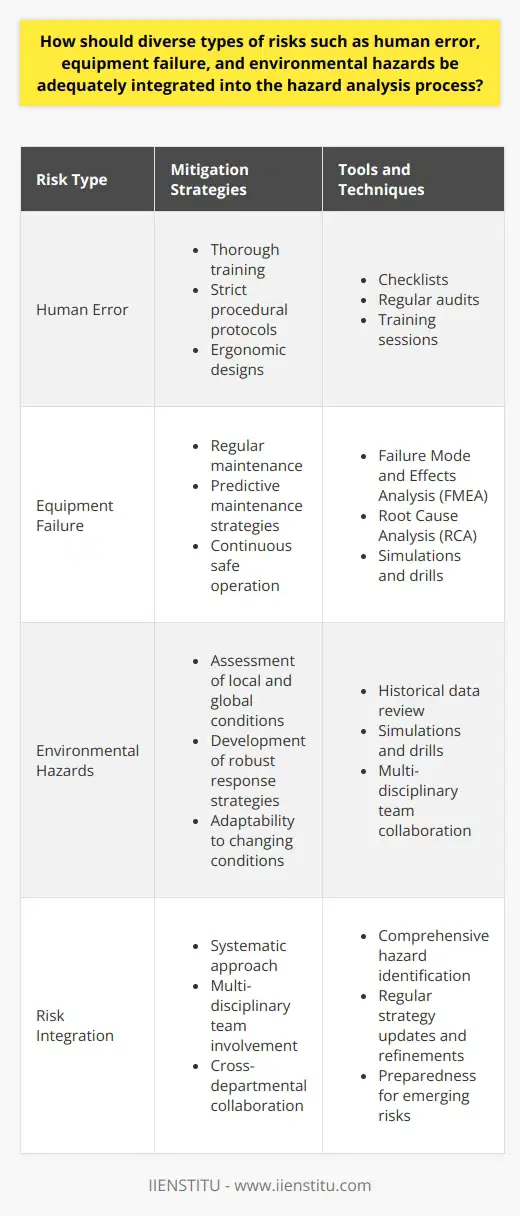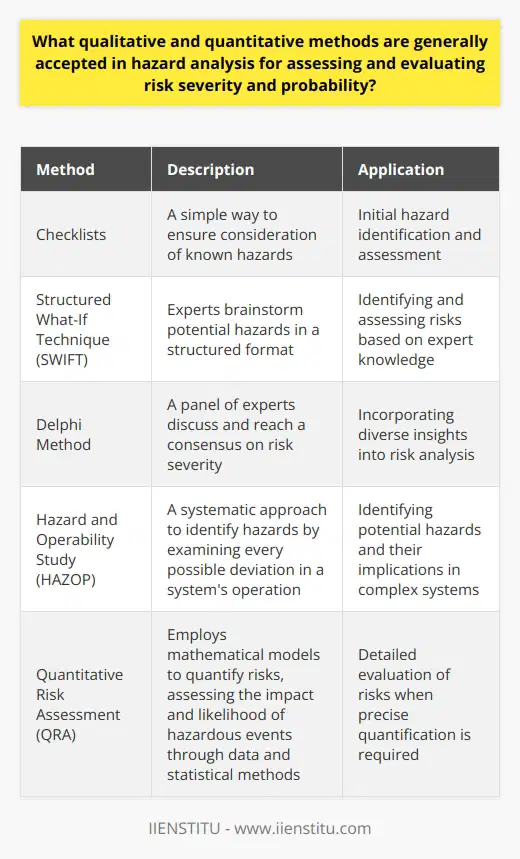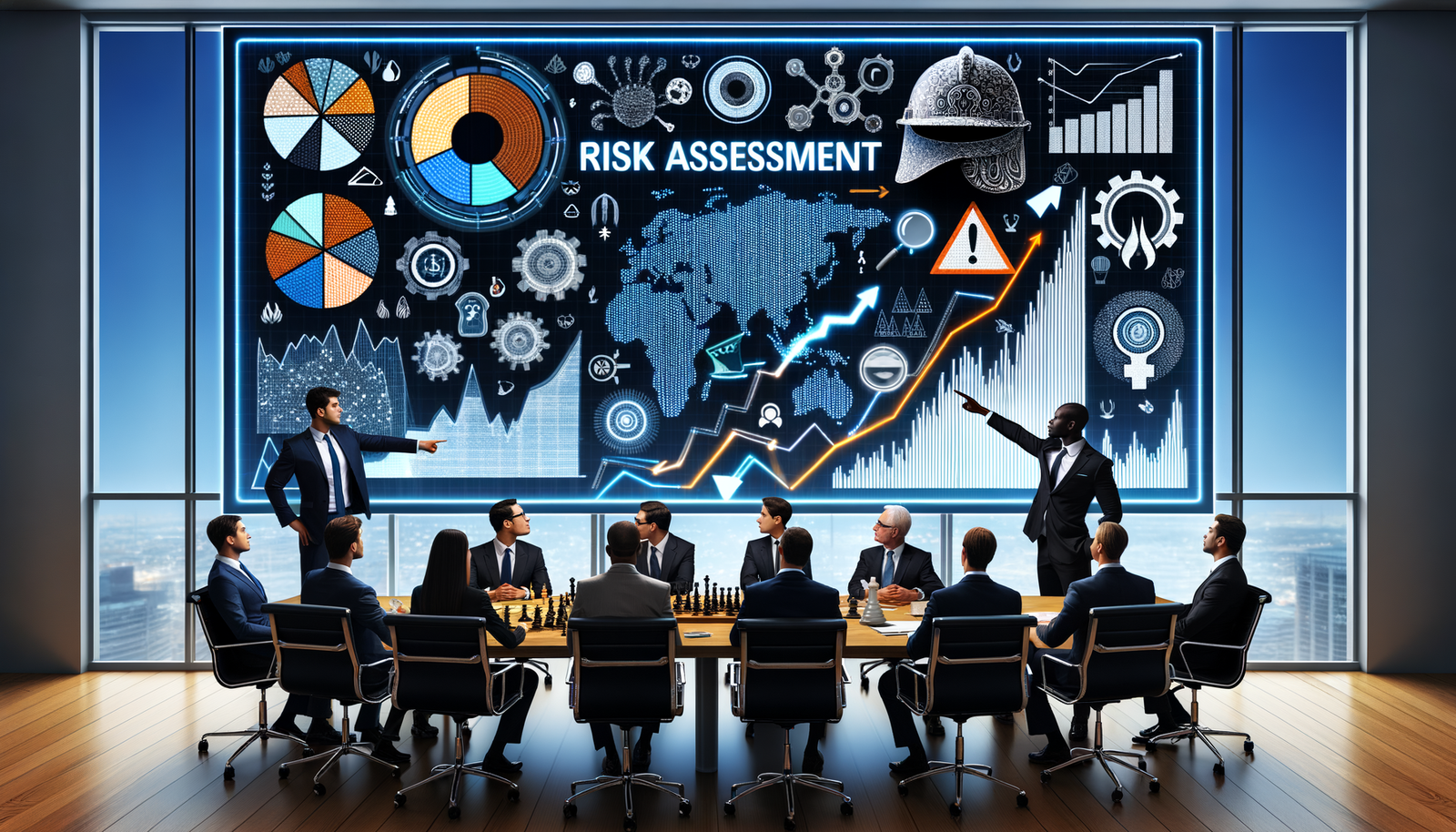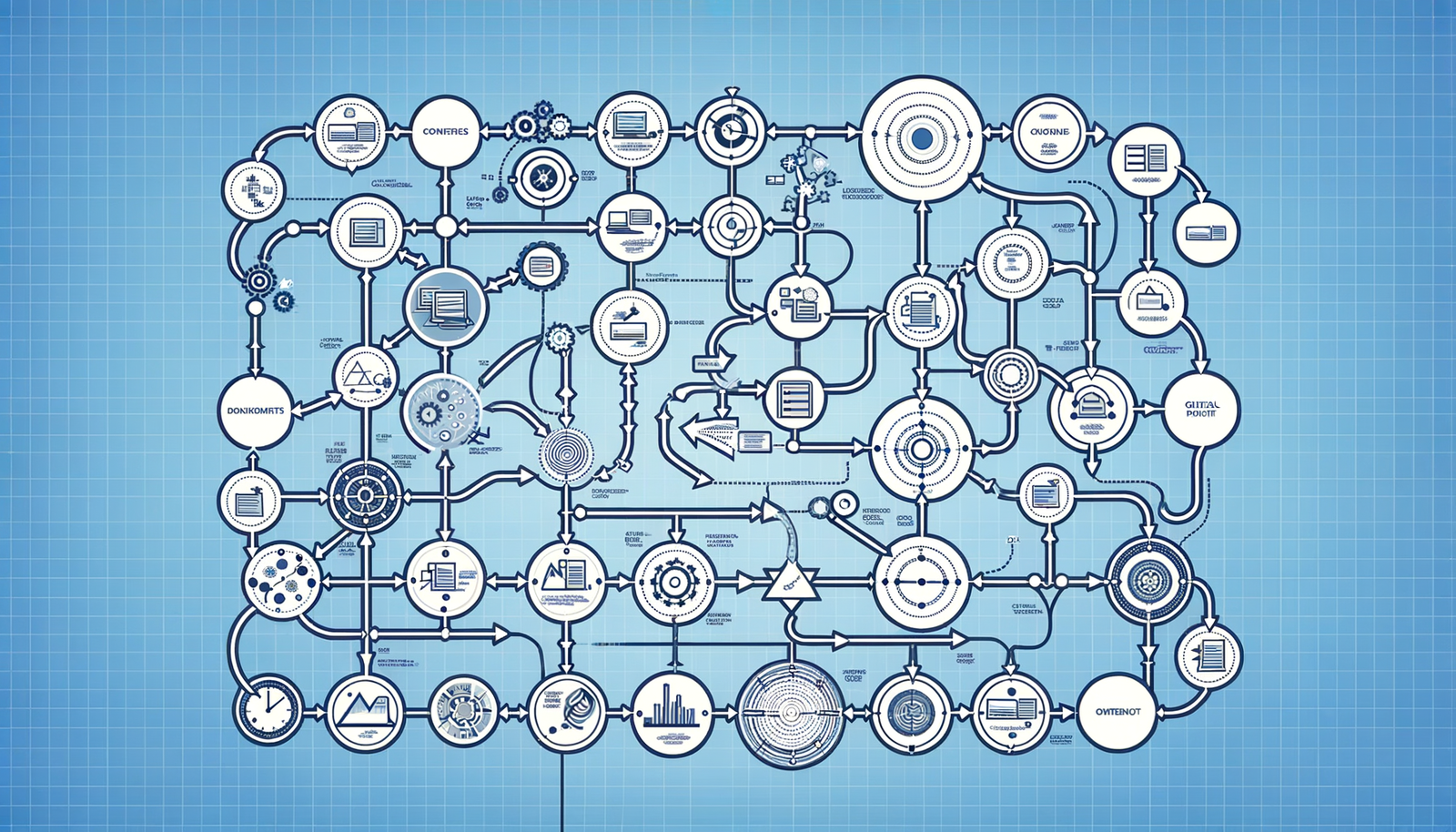
In the realm of operational efficiency and safety, Hazard Analysis stands as a cornerstone methodology for preempting and mitigating risks. Through its rigorous application, organizations are empowered to dissect processes or systems to uncover potential hazards that may cause harm to people, property, or the environment. Both the identification and the management of hazards are essential for ensuring operational safety and for upholding industry regulations. As an analytical framework, Hazard Analysis is indispensable across multiple sectors, from healthcare to manufacturing, effectively serving as a protective veil against unforeseen adversities. Hence, acquiring a problem solving certification or engaging in an online certificate course in Hazard Analysis can be valuable for professionals looking to deepen their expertise in this crucial area.
Understanding the Process of Hazard Analysis
Principles and necessary skills for Hazard Analysis
The proficiency to conduct a Hazard Analysis requires a confluence of critical thinking, a meticulous eye for detail, and comprehensive knowledge of industry-specific protocols. Personnel entrusted with this evaluation must exercise systems thinking, a capability to understand how different parts of a workflow or a system interrelate and may potentially contribute to a hazardous outcome. A robust problem solving certification can refine these requisite skills, equipping professionals with the competencies to dissect and scrutinize complex systems effectively.
Step-by-step procedure of conducting a Hazard Analysis
In conducting a Hazard Analysis, experts follow a detailed, stepwise approach starting with hazard identification. This phase involves investigating all elements within a process to flag any potential sources of harm. Following identification, the next step is hazard assessment and evaluation, wherein each identified risk is analyzed for its severity and likelihood of occurrence. Control measures for hazards are then devised, tailored to mitigate or eliminate the identified risks, positive proof of the efficiency of a well-devised analysis.
Finally, the entire process hinges on thorough documentation of Hazard Analysis, which serves as official records that guide safety protocols and serve as a reference for continuous improvement.
Emphasize the cyclic nature of Hazard Analysis process
It is pivotal to recognize that Hazard Analysis is not a one-time task but a cyclical process that demands ongoing attention and periodic reviews. As operational landscapes and technologies evolve, so does the nature of potential hazards, making it crucial for organizations to reevaluate and update their hazard analyses.
This continuous feedback loop ensures that hazard management strategies remain current and effective against the dynamic tapestry of risks.
Types of Hazard Analysis
Preliminary Hazard Analysis
Preliminary Hazard Analysis is a rudimentary yet essential part of early project stages. It lays the groundwork for safety considerations by providing an initial assessment to identify obvious risks and establish priorities for further, more detailed analyses.
System Hazard Analysis
Conversely, System Hazard Analysis delves into the interworking components of a complete system. It systematically evaluates the integration and interaction of subsystems to identify risks that may not be evident when viewing components in isolation.
Subsystem Hazard Analysis
Subsystem Hazard Analysis concentrates on the constituent parts of a larger system. Each subsystem is analyzed to unearth potential hazards particular to its operation or malfunction.
Operating Hazard Analysis
Operating Hazard Analysis, then, reviews the actual day-to-day operation of a system. It closely monitors the practical use and the human-machine interface, recognizing that different conditions of use can lead to diverse risks.
Use of specific examples to highlight each type
Real-world examples bring clarity to these methodologies. For instance, in aerospace engineering, Preliminary Hazard Analysis might highlight the generic risks of high-speed flight, while a System Hazard Analysis could scrutinize the spacecraft's life-support system, Subsystem Hazard Analysis might assess the oxygen recycling components, and Operating Hazard Analysis examines the risks during atmospheric re-entry phases.
The Role of Hazard Analysis in Various Industries
Hazard Analysis in the manufacturing industry
In manufacturing settings, Hazard Analysis is essential for maintaining product quality and worker safety. It is used to proactively identify potential points of failure within the manufacturing processes that could lead to defects or accidents, thereby safeguarding both the workforce and consumers.
The application of Hazard Analysis in the construction industry
In the construction industry, hazards are abundant and therefore a detailed Hazard Analysis can dramatically reduce the risk of worksite accidents. It ensures that potential risks, such as structural failures or electrical hazards, are addressed before they can materialize into incidents.
Hazard Analysis in the Healthcare field
For healthcare, the implication of Hazard Analysis is profound when patient safety is concerned. It can be utilized to predict and prevent medical errors, manage the biohazard risks, and secure sensitive data against cyber threats.
The importance of Hazard Analysis in the food & beverage industry
In food & beverage, Hazard Analysis is mandated by regulatory authorities to prevent foodborne illnesses. It forms the backbone of many food safety management systems, emphasizing the need for cleanliness, temperature control, and contamination prevention measures throughout the food handling process.
Common Challenges in Conducting Hazard Analysis
Difficulty in identifying all potential hazards
One of the perennial challenges in executing an effective Hazard Analysis is the comprehensive identification of potential hazards. Complex systems and unforeseen variables can complicate the detection process, often requiring a high level of expertise and experience.
The challenge of risk quantification and assessment
Moreover, once hazards are identified, the quantification and assessment of risk pose their own set of difficulties. Not all hazards are easily measurable, and qualitative assessments must often be applied, demanding a nuanced approach to valuation.
The problem of implementing effective control measures
Furthermore, even when hazards are assessed, the problem of implementing effective control measures arises. The feasibility, cost, and practicality of control strategies must be weighed against the benefits of risk mitigation, often requiring ingenious and multi-disciplinary solutions.
Documentation and record-keeping dilemmas
Lastly, the aspect of documentation and online certificate course in hazard control underscores the procedural importance of record-keeping. Effective Hazard Analysis requires meticulous documentation, which can sometimes be onerous but is necessary for regulatory compliance and improvement tracking.
Case Studies of Hazard Analysis
Case Study 1: (Select a relevant example in the context of the chosen industry)
Conducting a case study, such as analyzing the use of Hazard Analysis in mitigating the risks associated with chemical storage in a petrochemical plant, illustrates the practical applications and significant outcomes realized through this analytic method.
Case Study 2: (Select a significant event where hazard analysis was crucial)
Another case may involve reviewing how Hazard Analysis played a crucial role in averting disaster during a pharmaceutical manufacturing process where cross-contamination risks were identified and contained through strategic interventions.
Ways to Improve the Effectiveness of Hazard Analysis
Using analytical tools and software
To enhance the accuracy and efficacy of Hazard Analysis, analytics tools, and dedicated software can significantly expedite and improve the hazard identification and assessment phases, providing comprehensive and data-driven insights.
Regular training and workshops for staff
Additionally, continuous education through regular training and workshops for staff ensures that teams are up-to-date with the latest safety practices and regulatory requirements, boosting the overall quality of the Hazard Analysis conducted.
Establishing a standard set of practices for Hazard Analysis
To fortify consistency across analyses, establishing a standard set of practices for Hazard Analysis provides a uniform lens through which risks can be evaluated, greatly improving inter-departmental coherence and collaboration.
Regular revisions and updates of hazard documentation
Regular revisions and updates of hazard documentation are indispensable for the reflection of changing conditions and the inclusion of novel safety concerns, thus fortifying the adaptive capability of Hazard Analysis.
The significance of Hazard Analysis
In summary, Hazard Analysis is indisputably significant, acting as an essential strategic tool for risk evaluation and management across a multitude of sectors. Its impacts are far-reaching and critical in safeguarding both human and environmental welfare.
Recapping its influence across various industries
The article has meticulously traversed the impact of Hazard Analysis across industries, dissecting the process, delineation of types, challenges faced, exemplar case studies, and strategies for enhancing its effectiveness, thus underpinning its versatility and relevance.
Encouragement and advice for implementing effective Hazard Analysis practices
Organizations are therefore encouraged to invest in proper Hazard Analysis practice and ensure that their staff acquires adequate training, such as a problem solving certification or an online certificate course. By championing Hazard Analysis, they not only ensure compliance and safety but also foster a culture of proactive risk management, which stands at the vanguard of operational excellence.
Frequently Asked Questions
What are the key factors to consider in a comprehensive approach to hazard analysis?
Understanding Hazard Analysis
A comprehensive approach to hazard analysis is pivotal. It ensures the safety and integrity of processes. Several factors merit attention in this assessment.
Identify All Potential Hazards
The first step involves recognizing threats. Consider chemical, physical, biological, and ergonomic risks. This variety ensures we miss no potential hazard.
Evaluate the Risk of Each Hazard
Each identified threat requires a risk evaluation. We must determine the likelihood and potential impact. This approach prioritizes the most serious risks.
Consider the Exposure Duration
Duration and frequency of exposure are critical. Long-term exposure can increase risks significantly. This element must factor into the overall analysis.
Contextual Analysis is Crucial
Understand the context of potential hazards. This means considering the environment where hazards exist. Context shapes how we view and manage risks.
Assess Vulnerable Populations
Populations vary in their vulnerability. Age, health status, and other factors can elevate risk. Tailor hazard analysis to protect these groups effectively.
Look at Historical Data
Prior incidents provide valuable insights. Investigate past events and root causes. Learning from history helps prevent future occurrences.
Include Human Factors
Human error plays a role in many accidents. Analyze and mitigate factors leading to human error. Training and procedural safeguards can reduce this risk.
Implement Control Measures
Once hazards are identified and prioritized, develop control measures. These should be practical and maintainable solutions. They reduce or eliminate the identified risks.
Monitor and Review Regularly
Hazard analysis is not a one-time event. Conditions and processes change. Regular monitoring ensures control measures remain effective.
Engage Stakeholders
Stakeholder engagement enhances hazard analysis. Workers, management, and community members provide diverse perspectives. Their input leads to more robust hazard mitigation strategies.
Incorporate New Technologies and Information
Stay abreast of technological advances and new information. Modern tools can revolutionize hazard analysis. They make processes safer and more efficient.
Document and Communicate
Documentation ensures accountability and transparency. It also aids in communication across the organization. Clear communication of hazards promotes awareness and adherence to safety protocols.
The above strategies provide a framework to manage potential risks effectively. A comprehensive hazard analysis is an evolving process. It demands continuous attention and refinement to safeguard against the myriad of possible dangers inherent to any operation or task.

How should diverse types of risks such as human error, equipment failure, and environmental hazards be adequately integrated into the hazard analysis process?
Understanding Risk Integration in Hazard Analysis
Hazard analysis forms a crucial part of safety management. It demands an understanding of various risks. These include human error, equipment failure, and environmental hazards. Integrating these risk types can seem complex. Yet, it is essential for thorough safety assessments.
Identifying and Categorizing Risks
Identification stands as the first step. Not all risks are equal. They vary in nature and impact. Classifying risks aids in their effective management. Employ a categorization system. This should reflect the unique characteristics of each risk type.
Assessing the Likelihood and Severity
Each risk carries its likelihood and potential severity. Assess these aspects rigorously. Tools such as Failure Mode and Effects Analysis (FMEA) can help. So can Root Cause Analysis (RCA). These help quantify and prioritize risks.
Human Error
Human error is unpredictable. Yet, it is one of the most common risk sources. Use thorough training to mitigate it. Implement strict procedural protocols. Adopt ergonomic designs. They reduce the chances of errors.
Equipment Failure
Reliable equipment is non-negotiable. Regular maintenance plays a key role. Implement predictive maintenance strategies. They can forecast potential failures. This limits unscheduled downtimes. It ensures continuous safe operation.
Environmental Hazards
Environmental risks require special attention. Assess local and global environmental conditions. Understand how they can affect operations. Develop response strategies. They should be robust and adaptive to changing conditions.
Integrating Risk in the Hazard Analysis Process
Integrate risks through a systematic approach. Employ a multi-disciplinary team. They should have varied skills and knowledge. Collaborate across departments. This ensures comprehensive hazard identification.
- Use checklists
- Conduct regular audits
- Hold training sessions
- Review historical data
- Conduct simulations and drills
Conclusion
A well-integrated hazard analysis saves lives. It protects equipment and the environment. It requires effort and commitment. The benefits, however, are immeasurable. Always update and refine your strategies. Stay prepared for emerging risks. Safety is an ongoing journey.

What qualitative and quantitative methods are generally accepted in hazard analysis for assessing and evaluating risk severity and probability?
Qualitative Methods in Hazard Analysis
Experts often turn to qualitative methods when assessing hazards. These methods focus on the description and characteristics of risks rather than numerical values. One common approach is the use of checklists. Checklists provide a simple way to ensure consideration of known hazards.
Expert Judgment
Expert judgment plays a crucial role here. Professionals with relevant experience weigh risks based on their knowledge. They often rely on tools like SWIFT (Structured What-If Technique). SWIFT allows these experts to brainstorm potential hazards in a structured format.
Delphi Method
Another qualitative technique is the Delphi method. This involves a panel of experts who discuss and reach a consensus on risk severity. It ensures that a diverse range of insights contribute to the analysis.
Hazard and Operability Study (HAZOP)
HAZOP is a systematic approach to identify hazards. It examines every possible deviation in a system's operation. It asks what could go wrong and what the implications might be. This method requires a multidisciplinary team working through a set of guide words.
Quantitative Methods in Hazard Analysis
When precision is needed, quantitative methods come into play. These methods assign numerical values to risks, providing a more exact measure of hazard severity and probability.
Fault Tree Analysis (FTA)
FTA maps out the various ways a system can fail. It uses logic symbols to represent failures and their interrelations. This helps determine the likelihood of a top-level event, such as a system breakdown.
Event Tree Analysis (ETA)
Closely related is Event Tree Analysis (ETA). ETA starts with an initiating event and maps out possible outcomes. It quantifies the probability of different scenarios following an incident.
Bow-Tie Model
The Bow-Tie Model combines qualitative and quantitative elements. It visualizes the path from causes to consequences. This dual approach helps in understanding the link between preventative and mitigative controls.
Quantitative Risk Assessment (QRA)
For a detailed evaluation, one might use Quantitative Risk Assessment (QRA). It employs mathematical models to quantify risks. QRA assesses the impact and likelihood of hazardous events through data and statistical methods.
Evaluating Risk Severity and Probability
Both qualitative and quantitative methods serve in evaluating risks. The choice depends on the context and available data.
- Use qualitative methods for broad, initial assessments.
- Turn to quantitative techniques for detailed analysis.
Combining Methods
Often, analysts will combine both approaches. They might start with a qualitative method to identify risks. Then, they'll use quantitative tools to delve deeper into high-priority areas. This combination harnesses the strengths of both techniques: the depth of qualitative insights and the precision of quantitative data.
Conclusion
Risk analysis requires a balanced approach. It blends qualitative understanding with quantitative evidence. As hazards evolve and new threats emerge, these methods adapt. They do so to protect against the unforeseen and ensure safety in our complex world.



